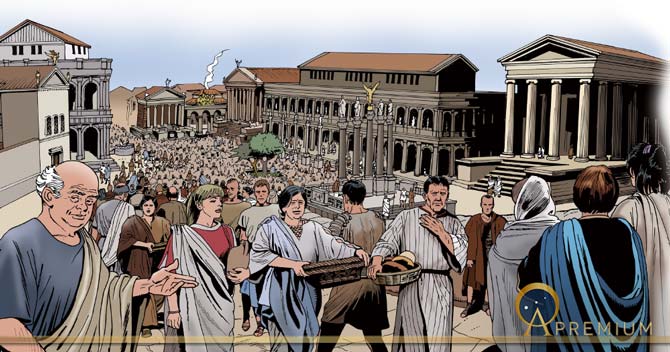Strolling Through Augustan Rome With Roberto The Roman
Like many ancient cities, and some modern, Augustan Rome was a combination of public magnificence and private squalor. There were the temples, the aqueducts, the basilicas, and other grandiose public buildings, and there were the seedy back streets, the dilapidated tenements, and the piles of odiferous waste. Augustus’ biographer Suetonius claims the emperor remarked, “ I found a city of brick and left it a city of marble.” But if he did utter those immortal words, this is certainly an exaggeration. It is true that he restored numerous temples that had fallen into disrepair during the Civil War era and that he undertook several high-profile vanity projects, but bricks remained the chief building material. Speaking of temples, they were what would have awed visitors most when they first entered the city. There were over a dozen dedicated to Jupiter alone.
Overcrowding, Traffic Jams and Bodyguards
By the time Augustus became princeps or ‘first citizen’, as he chose to be called, in 27 BC, Rome was heavily overpopulated, and if he is to be given credit for transforming the city, which he should, it is for facilitating a building bonanza to increase housing. A vague estimate of Rome’s population at the time may well be hovering around one million. It is hard to imagine close to one million people crammed inside a circuit wall which barely encloses three square miles (7.7 square kilometers).

Wealthy woman being transported in a litter through the overcrowded streets of Rome. ( Massimo Todaro/ Adobe Stock)
Rome was not built on a grid pattern. The historian Livy said that it was constructed in a hurry – if not exactly in a day – after its predecessor had been razed to the ground by the invading Gauls in 390 BC and that it resembled a city “ casually built by squatters rather than one that had been carefully planned.” Few of the streets were straight and few were wide enough to allow two carts to pass in opposite directions. Daytime snarl-ups were all-too-frequent, despite the efforts of the local authorities to regulate the traffic flow. It was a wonder that the whole place did not grind to a halt. To cut down on the congestion, Julius Caesar introduced a law permitting wheeled vehicles into the city only after sunset, though if they were carrying construction materials, they were exempted. Caesar’s ban on daytime wheeled traffic meant inhabitants were forced to listen to carts trundling over cobbled streets incessantly at night.
READ MORE…
Like this Preview and want to read on? You can! JOIN US THERE ( with easy, instant access ) and see what you’re missing!! All Premium articles are available in full, with immediate access.
For the price of a cup of coffee, you get this and all the other great benefits at Ancient Origins Premium. And - each time you support AO Premium, you support independent thought and writing.
Dr Robert Garland obtained his M.A. in Classics from McMaster University and his Ph.D. in Ancient History from University College London. His research focuses on the social, religious, political, and cultural history of both Greece and Rome. He has written 17 books including Roman Legends Brought to Life
Top Image: Roberto the Roman welcoming the traveler to bustling Rome(Massimo Todaro /Adobe Stock)
















